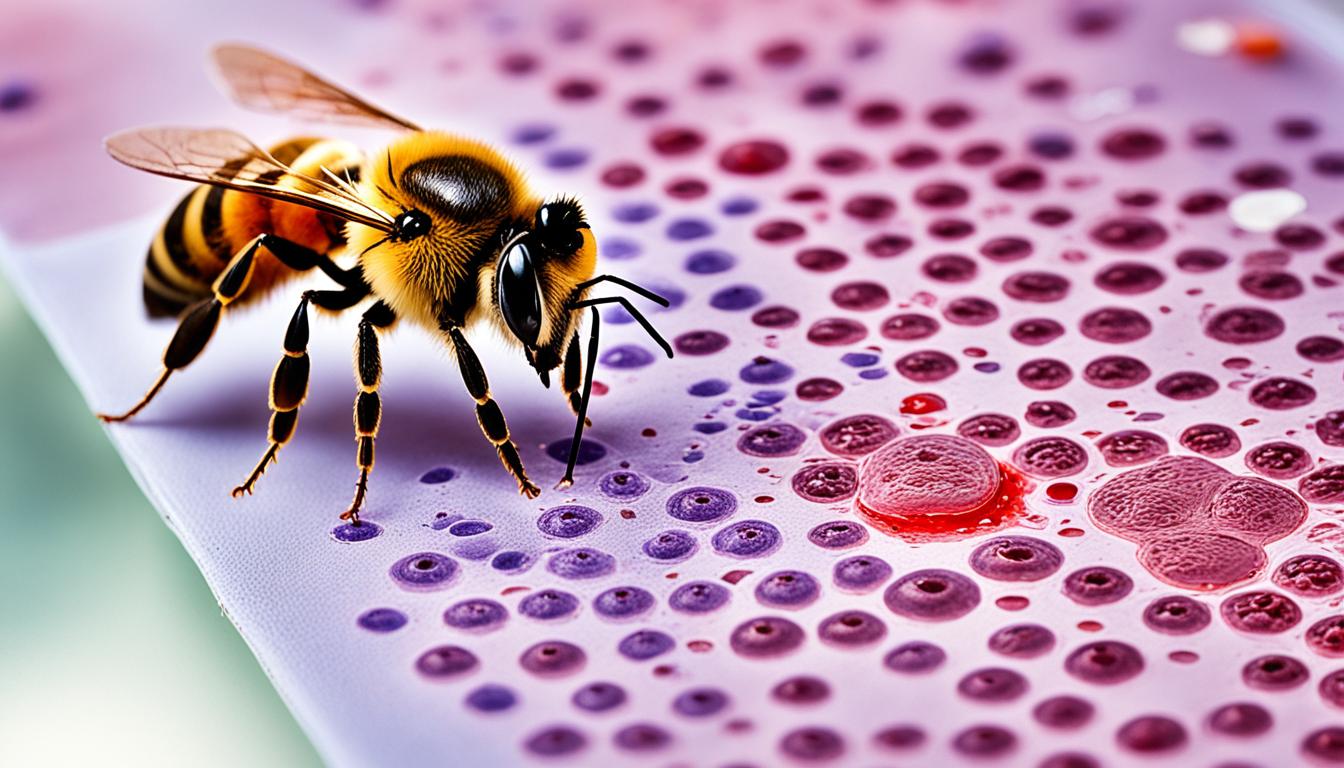Welcome to our informative article on bee sting disease. We will talk about symptoms, causes, diagnosis, and treatments, including stem cell therapy. Bee venom shows potential in treating cancer, neurological disorders, and more.
Bee sting disease, or apitoxinosis, happens when someone reacts to a bee sting. Some people get minor symptoms like redness and swelling. But, for others, the reaction can be much worse.
Doctors diagnose bee sting reactions by looking at symptoms and allergy history. It’s important to understand these reactions well. This helps improve treatments and make new ones.
Recently, stem cell therapy has started to be a possible treatment for bee sting disease. These cells can fix tissues and lessen inflammation from bee venom. Research is still going on, but it’s hopeful for better results in the future.
Let’s dive into the world of bee stings and learn about bee sting disease. Looking for info on symptoms, causes, or treatments? You’re in the right place!
Key Takeaways:
- Bee venom has various pharmacological effects with therapeutic potential in treating cancer, neurological disorders, inflammatory diseases, pain, and more.
- Bee sting reactions can range from mild local symptoms to severe systemic or allergic reactions.
- Diagnosis of bee sting reactions is based on the patient’s symptoms and history of allergies.
- Stem cell therapy shows promise as a potential treatment for bee sting disease by promoting tissue repair and reducing inflammation.
- Further research is needed to fully understand the causes and mechanisms of bee sting reactions and develop innovative therapies.
The Pharmacological Effects of Bee Venom and its Main Components
Bee venom is full of active parts like melittin, phospholipase A2, and apamin. These are what give it its powerful effects.
Melittin is a major part of bee venom. It fights bacteria and tumors. Research is looking into how it can stop cancer cells from growing and spreading.
Bee venom phospholipase A2 is crucial too. It breaks down membrane phospholipids. This leads to its anti-tumor and anti-infection powers. Studies suggest it could help fight cancer, inflammation, and infections.
Apamin might be found in smaller amounts but is still mighty. It can help with heart and artery health. It also may protect the nervous system.
The main parts of bee venom work together to create its effects. The way these parts act is complex. They target and move through various pathways.
Pharmacological Effects of Bee Venom Components
| Component | Pharmacological Effects |
|---|---|
| Melittin | Antibacterial, Anti-tumor, and Other Effects |
| Phospholipase A2 | Anti-tumor, Anti-infectivity |
| Apamin | Anti-atherosclerosis, Anti-heart failure, Neuroprotective |
The study of bee venom and its parts is drawing a lot of interest. It opens the door to new treatments for many diseases. Understanding how these effects work could be key.
Bee Venom and Cancer Treatment
Bee venom and its key part, melittin, show promise in fighting cancer. They can block cancer from starting and growing. These discoveries open up new ways to treat cancer.
Research shows bee venom stops cancer cells from growing and spreading. It also makes them die off in a process known as apoptosis. These actions help stop tumors from getting bigger and spreading.
Bee venom affects certain proteins and pathways that help cancer grow. For instance, it blocks the PI3K/Akt and MAPK pathways. These pathways are important in tumor growth.
Bee venom works against many cancer types, like breast and lung cancer. Studies show it can make standard cancer treatments work better. It does this by making cancer cells more sensitive to these treatments.
Potential Clinical Applications
The good news about bee venom means it might be used in treating cancer. Researchers are working to find new ways to use bee venom or its parts in therapy.
Experts are looking into how to deliver bee venom safely and effectively. They are studying nanostructures and specific peptides from bee venom. These studies aim to use the venom without harmful side effects.
More research and tests with patients are needed. We need to find the best dose and how to give it safely. This will help us know if bee venom therapies can truly help cancer patients.
| Bee Venom’s Anti-Tumor Effects | Targeted Pathways |
|---|---|
| Regulation of cell cycle | PI3K/Akt pathway |
| Inhibition of proliferation and migration | MAPK pathway |
| Promotion of programmed cell death (apoptosis) | – |
Bee venom gives us hope in cancer research and developing new therapies. Understanding how it works against cancer helps us make progress. It opens doors to better treatments in the future.
Symptoms and Diagnosis of Bee Sting Reactions
If you get stung by a bee, you might notice several signs. These include redness, swelling, pain, and itching where you were stung. Usually, these symptoms go away after a few hours or days.
Sometimes, bee stings can lead to more serious problems. If you have an allergic reaction, it can be severe. Signs of a severe reaction include:
- Hives
- Swelling of the mouth or throat
- Wheezing
- Shortness of breath
- Nausea
- Vomiting
- Chest pain
These severe reactions can be dangerous. If you experience them after a bee sting, get medical help right away.
Doctors diagnose bee sting reactions by looking at your symptoms and your health background. They’ll ask if you’ve had allergic reactions to bee stings before. They’ll check how severe and how long your symptoms are. To make sure, they might do blood tests or allergy tests.
Bee Sting Reaction Symptom Severity Scale:
| Symptom | Severity |
|---|---|
| Localized reaction (redness, swelling, pain) | Mild |
| Systemic reaction without respiratory or cardiovascular involvement | Moderate |
| Systemic reaction with respiratory or cardiovascular involvement | Severe |
| Anaphylactic shock | Life-threatening |
Knowing how severe a bee sting reaction is helps doctors decide on a treatment. Always see a healthcare professional to get the right help for bee sting reactions.
Complications and Treatment of Bee Sting Reactions
Bee stings can lead to serious issues like muscle breakdown, kidney failure, and death. It’s crucial to know the risks and act accordingly. Anaphylactic shock is one serious reaction that can be deadly.
Remove the stinger right away to stop more venom from getting in. Cold compresses can lessen pain and swelling. But if there’s trouble breathing, chest tightness, or blood pressure drops, seek help fast.
If someone has anaphylactic shock, adrenaline is key. It fights the severe allergic reaction and helps blood flow right. Watching vital signs and urine is vital, as serious cases might need extra treatments.
| Complications of Bee Sting Reactions | Treatment |
|---|---|
| Muscle breakdown | Monitoring vital signs and urine output |
| Kidney failure | Administering adrenaline for anaphylactic shock |
| Death | Applying cold compresses to the affected area |
Always get medical help if bee stings cause bad problems. Quick action and monitoring are key for a good outcome and avoiding danger.
Prognosis and Prevention of Bee Sting Reactions
The outlook after a bee sting varies. It depends on the bee type, how many times you were stung, and your health status. Most people have mild reactions that go away on their own. However, some might get severe allergic reactions needing quick medical help. Knowing these factors helps in managing bee sting reactions properly.
Prognosis Factors
Certain things affect bee sting reactions:
- The type of bee: Bees have different venom types. For example, honeybees (Apis mellifera) have strong venom, raising the risk of serious reactions.
- The number of stings: More stings mean a greater risk, especially for those with allergies or health issues.
- Co-morbid diseases: People with diseases like asthma or heart problems may react worse to bee stings.
Prevention of Bee Stings
It’s key to avoid bee stings. Here are ways to prevent them:
- Avoiding bee habitats: Stay away from places where bees hang out, like flowerbeds, hives, or picnic spots.
- Wearing protective clothing: Dress in long sleeves, pants, shoes with toes covered, and a hat if you’ll be around bees.
- Using insect repellents: Choose repellents designed to keep bees and wasps away when outside.
- Being cautious with food and drinks: Bees like sweets and sugary drinks. Keep them covered to not attract bees.
- Resisting the urge to swat: Don’t swat at bees. It might make them more likely to sting. Stay calm and slowly move away if a bee comes close.
People who are allergic to bee stings should be extra careful. They should always have an epinephrine auto-injector with them. This can quickly treat severe allergic reactions and is used while waiting for medical help.
| Prognosis Factors | Preventive Measures |
|---|---|
| 1. Type of bee | 1. Avoiding bee habitats |
| 2. Number of stings | 2. Wearing protective clothing |
| 3. Co-morbid diseases | 3. Using insect repellents |
| 4. Being cautious with food and drinks | |
| 5. Resisting the urge to swat |
Lightning Safety
Lightning is a big weather danger, especially outside during physical activities. It’s vital to focus on lightning safety to lower the chance of accidents and injuries.
Follow these important steps to stay safe when there’s lightning:
- Monitor weather conditions: Check the weather before outdoor activities. Look out for lightning warnings from local or weather services.
- Seek shelter: Go inside immediately if you hear thunder or see lightning. A solid building or an enclosed metal vehicle is safe from lightning.
- Avoid open areas: Don’t be in open fields, high places, near tall trees, or water during storms. These spots make lightning strikes more likely.
- Wait for thunderstorm clearance: Wait 30 minutes after the last thunder or lightning to go back outside. This ensures the storm has moved on.
- Stay low: If stuck outside with no shelter, crouch low to the ground. Keep away from things that might attract lightning.
By taking these steps, you can really cut down your risk of lightning strikes. This helps keep you safe when the weather turns bad.

Never ignore lightning safety advice. Always be aware, find safe shelter, and put safety first to reduce lightning dangers.
Conclusion
Bee sting disease can lead to allergic reactions and anaphylactic shock. It’s important to know the signs and get help if needed. Taking steps to avoid bee stings can lower the risk of these problems.
Researchers are looking at new treatments, like stem cell therapy. They’re exploring how bee venom could help fight cancer and other illnesses. This could lead to big advancements in health care.
Preventing bee stings is the best strategy. Stay away from places where bees are common. Wear clothes that cover your skin and use bug spray. If you’re allergic, always have adrenaline ready. Being aware and prepared can keep you safe from bee stings.

